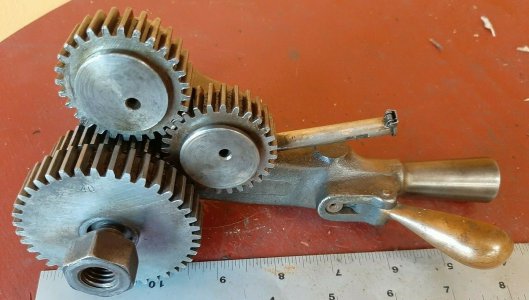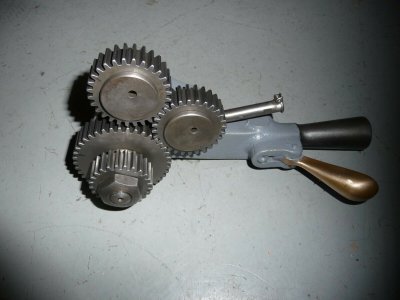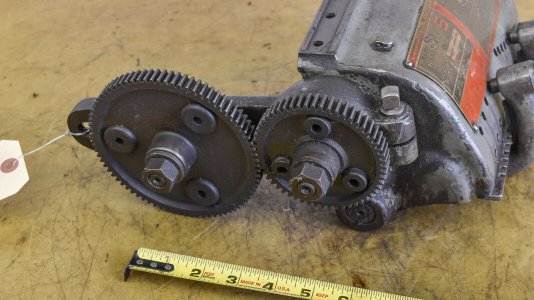-
Welcome back Guest! Did you know you can mentor other members here at H-M? If not, please check out our Relaunch of Hobby Machinist Mentoring Program!
You are using an out of date browser. It may not display this or other websites correctly.
You should upgrade or use an alternative browser.
You should upgrade or use an alternative browser.
Forward / Reverse Lever for South Bend Heavy 10 ?
- Thread starter Don T
- Start date
- Joined
- Dec 6, 2015
- Messages
- 828
Edit.... it helps if I read the whole post.
You will need that assembly. If it comes with the removable gear, that's even better. Mine typically has a 16 tooth on it for regular turning.
The pitch on the removable gear is 16, while the three gears that aren't removable are 18 pitch. The removable gear is the stud gear on the change gears.
Do you have a quick change gear box, or is it all change gears?
joe
You will need that assembly. If it comes with the removable gear, that's even better. Mine typically has a 16 tooth on it for regular turning.
The pitch on the removable gear is 16, while the three gears that aren't removable are 18 pitch. The removable gear is the stud gear on the change gears.
Do you have a quick change gear box, or is it all change gears?
joe
- Joined
- Aug 29, 2016
- Messages
- 852
By the South Bend parts manual, all of the major components of the reversing tumbler are unique to the Heavy 10.
- Joined
- Jun 1, 2020
- Messages
- 45
Yes I have the QCGB in this pic. So the main thing is that gear on each in the pics that is different sized changes thread pitch. Thanks I am still learning about my lathe. I got it for free and it was missing parts so I am just trying to get what it needsEdit.... it helps if I read the whole post.
You will need that assembly. If it comes with the removable gear, that's even better. Mine typically has a 16 tooth on it for regular turning.
The pitch on the removable gear is 16, while the three gears that aren't removable are 18 pitch. The removable gear is the stud gear on the change gears.
Do you have a quick change gear box, or is it all change gears?
joe
This is the gear box I bought (It fits fine) I grabbed it because it has the banjo gears also and I needed them to.
Attachments
- Joined
- Jun 1, 2020
- Messages
- 45
Any chance you could post a link to that chart? ThanksThere is a chart in Machinery's Handbook if you need to determine the diametral pitch of the gears. It is quite handy to
determine tooth size is that is what you need.
- Joined
- Feb 7, 2013
- Messages
- 2,531
Any chance you could post a link to that chart? Thanks
You will need to get your hands on a Machinery's Handbook to compare your gears to what is in the book.
- Joined
- Dec 6, 2015
- Messages
- 828
The heavy 10 used 16 pitch for all change gears, including the input shaft for the lead screw/ gear box, and the outboard gear on the two-gears-on-one-shaft on the reverse mechanism. The other gears on the reversing mechanism and the spindle are 18 pitch. I'll try to grab a photo if I can and identify which is which.
joe
joe
- Joined
- Dec 6, 2015
- Messages
- 828
I threw together another thread to talk about how things work for both reversing mechanisms, and diametral pitches. You can see that over here if you are interested, but I'll summarize that here.
The basic formula is the number of teeth on the gear plus two, and divide the resulting number by the diameter of the gear in inches. As an example, my south bend "junior" had a 16-tooth gear on the stud for regular turning. That gear was 1.125" in diameter. It means that 16 teeth, plus two (which is 18), divided by 1.125, comes out to "16". A 32 tooth gear had the diameter of 2.125", which means (32 + 2) / 2.125 = 16.

"A" is the spindle gear, "B" is the reversing mechanisms, "C" is the stud gear for threading using change gears, "D" is the idler", and "E" is the screw gear. "C", "D", and "E" are easily swappable for threading. The others are not. These three gears are all going to be the same gear pitch, which is 16 on mine. "A" and "B" have to be the same gear pitch as each other as well, but those are 18 pitch. What is inside the gear box, I'm not sure, but they all need to be the same pitch as each other as well.
Hopefully, this helps.
The basic formula is the number of teeth on the gear plus two, and divide the resulting number by the diameter of the gear in inches. As an example, my south bend "junior" had a 16-tooth gear on the stud for regular turning. That gear was 1.125" in diameter. It means that 16 teeth, plus two (which is 18), divided by 1.125, comes out to "16". A 32 tooth gear had the diameter of 2.125", which means (32 + 2) / 2.125 = 16.

"A" is the spindle gear, "B" is the reversing mechanisms, "C" is the stud gear for threading using change gears, "D" is the idler", and "E" is the screw gear. "C", "D", and "E" are easily swappable for threading. The others are not. These three gears are all going to be the same gear pitch, which is 16 on mine. "A" and "B" have to be the same gear pitch as each other as well, but those are 18 pitch. What is inside the gear box, I'm not sure, but they all need to be the same pitch as each other as well.
Hopefully, this helps.






